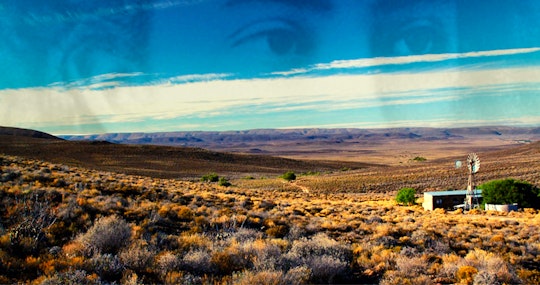Schreiner wrote that the Karoo makes one realise “many so-called important things are really insignificant, so many insignificant things important.” So, when the city’s starless nights and cordial, cramped offices become too much, I try to recall the dusty solitude of the Karoo to gain some perspective.
I learned this teleportation trick in my third year at varsity when I was hooked by Olive Schreiner’s poignant description of a Karoo night in The Story of an African Farm. Suddenly a lonely space with intermittent kopjes “like giants’ graves” leapt from the page, “a clump of prickly pears lifting their thorny arms” to “the full African moon”. You see, Schreiner could describe the Karoo so beautifully since she loved this region so well.
A writer, women’s rights activist, pacifist, anti-imperialist and outspoken non-racialist at a time when very few bore these labels, one would think that Schreiner had come from a big city or secular settlement. Quite the contrary! This remarkable figure was a veritable Karoo nomad and spent the greater part of her life moving around small Karoo towns, many of which retain the charm of days long passed. So, if you’re looking for a way to get to know this arid eden a little better, join TravelGround on a trip to the Karoo Olive Schreiner knew.
About Olive Schreiner

- Olive Emilie Albertina Schreiner was born to a Wesleyan missionary couple in 1855 and was named after her three older brothers who had died before her birth.
- She was asthmatic and the dry Karoo climate suited her health.
- She finished her most famous novel, The Story of an African Farm, by age 20, but it was only published at age 28 under the pseudonym Ralph Iron.
- Though she stayed in England between 1881 and 1889 and again between 1913 and 1919, she was at her most productive and influential whilst living in the Karoo.
- After reading African Farm in 1890, a Karoo farmer, Samuel Cronwright, started writing to her. The couple were married in 1894 when Schreiner was 38 and Cronwright 30. He, unusually, added her surname to his. She kept her maiden name.
- Schreiner only ever had one child, a daughter, who died soon after birth.
- Though a pacifist, Schreiner sided with Boer interests against the imperial power during the South African War.
- She died in Wynberg in 1920 and was buried in Kimberley, but her estranged husband had her reinterred at Buffelskop near Cradock, as was her wish, with her daughter and her dog, Nkita, by her side. Some years later, he would be interred there too.
Wittebergen near Lady Grey
“That almost intolerable beauty”

Schreiner spent the first ten years of her life at the Wittebergen mission station in the Eastern Cape. It was here, among the mountain slopes on a morning walk, that she remembers struggling with her earliest questions about the human condition and finding solace in the almost “intolerable beauty” of the landscape. It isn’t difficult to see why the landscapes around Lady Grey inspired Schreiner to believe that there were better, more beautiful ways of living. This little town is huddled below the Witteberg Mountain range, an imposing white-capped sight during winter and lush with grassy footpaths in summer.

Lady Grey was only established a year after Schreiner’s birth, but if you’re planning to visit the historical mission station some 23 kilometres away, we recommend you stay at the Mountain View Country Inn. Dalene, who manages the inn, gladly shares her knowledge and will point you in the right direction. On visiting Lady Grey it is worth visiting the sandstone Dutch Reformed Church built in 1913 and walking along the 25 meter high Lady Grey Dam.
Cradock
“A wild and beautiful place”

Schreiner lived in Cradock on three occasions. At the age of twelve she went to stay with her brother Theo, the headmaster of the local public school, and read a great deal of books from the public library, where there is still a room named after her. She became a governess at age fifteen and left for Barkley East and Colesberg before returning to Cradock where she completed The Story of an African Farm. While staying at Gannahoek Farm in the district she wrote to a friend: “The six months I have past here have been the most uninterruptedly happy of my whole life. This is a wild and beautiful place.” On Schreiner’s third return to Cradock, at age 38, she married Samuel Cronwright.
Buffelskop outside Cradock is also Schreiner’s final resting place. She shares her domed sarcophagus with her dog, Nkita, her unnamed baby daughter and her husband, with seemingly endless Karoo surrounding them on all sides. Tours to the site can be arranged through Buffelshoek Dirosie, a licensed game reserve and lodge. Tours have to be booked at least a week in advance, includes a pamphlet and a snack pack and takes up to four hours by 4×4 with a short walk at the end to complete ─ and guests may see some game along the way!

Cradock has a small but excellent museum in the house on Cross Street where Schreiner lived as a child and the town hosts the annual Olive Schreiner Karoo Writer’s Festival (from 8 to 11 June this year). There are also many architectural gems to see, such as the Die Tuishuise & Victoria Manor, as well as Karoo cottages which have been restored and are brimming with old world charm and history.

Matjiesfontein
“A sense of exhilaration and freedom comes over me”
After saving up enough from her governess work, Schreiner moved to England intending to study medicine, but her health prevented it. On return to South Africa in 1889 she stayed in Matjiesfontein, a grand hotel and railway-station village, for two years while her health improved. In a letter to Havelock Ellis she expressed her love for the veld around town, saying that “a sense of exhilaration and freedom [came] over [her] on [her] walks.” It has even been reported that Rudyard Kipling made a special journey to Matjiesfontein specifically to visit her.
After strolling through the town, its gardens and museums, it is worth making your way to a thoroughly secluded stay, much like a writer’s retreat in the vast Karoo. Snyderskloof Karoo Cottage is just 25 km from Matjiesfontein, and is the perfect spot to get some of the fresh Karoo air which so soothed Schreiner.

Kimberley
“It’s like having the sun in the house again”
As newly weds, Schreiner and Cronwright settled in Kimberley in 1872. Her time in Kimberley marks a happy marital period in which she once described her husband’s return after a few day’s absence as “having the sun in the house again”. After the death of her only daughter and with rising political tension and financial difficulty, the couple eventually relocated to Johannesburg, narrowly missing the Siege of Kimberley (1899 – 1900).

Some of Schreiner’s letters can be seen in the Africana Library in Du Toitspan Road and an exceedingly informative tour of this beautiful library can be arranged on request. More information on the siege is on display at the McGregor Museum, a natural history museum where Rhodes resided during the siege, and, of course, no trip to Kimberley is complete without a stop at the Big Hole Centre to experience the diamond industry in its heyday.

If you’re looking to stay over, try Jungnickel Guesthouse. This Victorian guest house is central, yet tucked away in a quiet corner and you’re ensured heartfelt service and hearty meals.
Beaufort West
“I begin to feel a new person.”
Although Schreiner never actually lived in town, she and Cronwright stayed on the farm Wagenaarskraal for a short while after leaving Johannesburg when the South African war broke out. Being back in the Karoo did Schreiner’s health well and she writes: “As soon as I get as low at Beaufort West I begin to feel a new person.”

On a trip through Beaufort a visit to the breathtaking Karoo National Park, home of the critically endangered riverine rabbit, and other game like the aardwolf, eland and mountain zebra, is not to be missed. If you’d like to experience the truly open skies and fresh air around Beaufort like Schreiner did, sleep over at Die Skooltjie, a historical farm cottage outside of town.

Hanover
“The prettiest village I have ever seen”
Soon after Wagenaarskraal, Cronwright arranged for himself and Schreiner to move to Hanover, where he opened a legal office. Here, the Schreiners lived with their dog, Nkita, and a family of meerkats for six years. Their house in Grace Street is still called Olive Schreiner House.
As outspoken boer supporters, the couple was welcomed by the Dutch population, and it was whilst living in Hanover that Schreiner met Emily Hobhouse, with whom she’d correspond until her death. Though much taken with Hanover, Schreiner and her husband’s relationship steadily deteriorated and, with the town under martial law, she had to cope with harsh restrictions and horrible scenes of war. To escape from the very real threats around her, she became increasingly interested in women’s rights and wrote her collection of feminist musings, Woman and Labour whilst staying here.
Today, Hanover remains a favourite stop along the N1 and is indeed the archetypal Karoo town. Take a walk up Trappieskop where South Africa’s first observatory stood to get a bird’s eye view of this pretty little village. And, if you’re looking to stay over, get your share of gracious Karoo hospitality at one of the quaint accommodation options in town.

After leaving Hanover for De Aar, the last Karoo town Schreiner lived in, her health declined so severely that she went to seek medical assistance in England and was stuck there by the outbreak of World War I. She died soon after her return to South Africa in 1920.
Whilst living in Sussex Schreiner wrote: “Our African sky gives one the […] sense of perfect freedom and wild exhilaration; sometimes one feels as though, for no reason that could be given, one were almost in an ecstasy of happiness when one goes out alone.” So, when looking for your next escape, close your eyes and imagine Schreiner’s expanse ─ or better yet, go there yourself.

Main image: Snyderskloof on TravelGround
All quotes in this blog are from The Olive Schreiner Letters Online, except for the quote from The Story of an African Farm.
All photos in this blog that are not acknowledged are from TravelGround.com.





